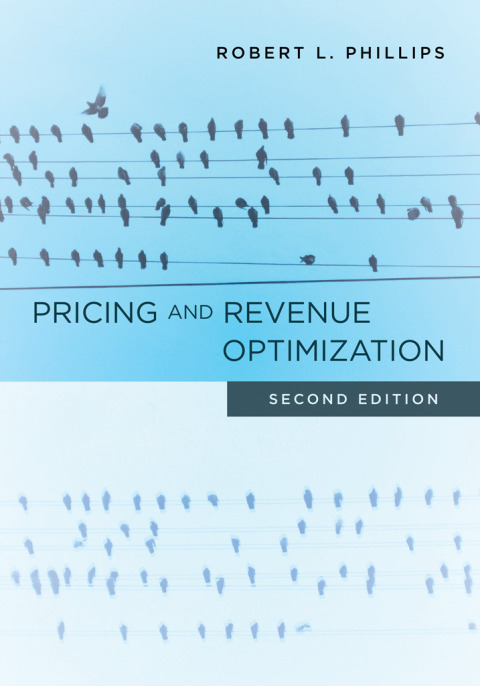Description
Efnisyfirlit
- Cover
- Title Page
- Copyright
- Contents
- Preface to the Second Edition
- Chapter 1: Background
- 1.1 Historical Background and Context
- 1.2 the Financial Impact of Pricing and Revenue Optimization
- 1.3 Organization of the Book
- 1.4 Further Reading
- Chapter 2: Introduction to Pricing and Revenue Optimization
- 2.1 the Challenges of Pricing
- 2.2 Traditional Approaches to Pricing
- 2.3 the Scope of Pricing and Revenue Optimization
- 2.4 the Pricing and Revenue Optimization Process
- 2.5 Summary
- 2.6 Further Reading
- 2.7 Exercise
- Chapter 3: Models of Demand
- 3.1 the Price-Response Function
- 3.2 Measures of Price Sensitivity
- 3.3 Common Price-Response Functions
- 3.4 Summary
- 3.5 Further Reading
- 3.6 Exercise
- Chapter 4: Estimating Price Response
- 4.1 Data Sources for Price-Response Estimation
- 4.2 Price-Response Estimation Using Historical Data
- 4.3 the Estimation Process
- 4.4 Challenges in Estimation
- 4.5 Updating the Estimates
- 4.6 Data-Free Approaches to Estimation
- 4.7 Summary
- 4.8 Further Reading
- 4.9 Exercises
- Chapter 5: Optimization
- 5.1 Elements of Contribution
- 5.2 the Basic Price Optimization Problem
- 5.3 Existence and Uniqueness of Optimal Prices
- 5.4 Optimization with Multiple Prices
- 5.5 a Data-Driven approach to Price Optimization
- 5.6 Competitive Response and Optimization
- 5.7 Optimization with Multiple Objective Functions
- 5.8 Summary
- 5.9 Further Reading
- 5.10 Exercises
- Chapter 6: Price Differentiation
- 6.1 the Economics of Price Differentiation
- 6.2 Limits to Price Differentiation
- 6.3 Tactics for Price Differentiation
- 6.4 Calculating Differentiated Prices
- 6.5 Price Differentiation and Consumer Welfare
- 6.6 Nonlinear Pricing
- 6.7 Summary
- 6.8 Further Reading
- 6.9 Exercises
- Chapter 7: Pricing with Constrained Supply
- 7.1 the Nature of Supply Constraints
- 7.2 Optimal Pricing with a Supply Constraint
- 7.3 Opportunity Cost
- 7.4 Market Segmentation and Supply Constraints
- 7.5 Variable Pricing
- 7.6 Variable Pricing in Action
- 7.7 Summary
- 7.8 Further Reading
- 7.9 Exercises
- Chapter 8: Revenue Management
- 8.1 History
- 8.2 Levels of Revenue Management
- 8.3 Revenue Management Strategy
- 8.4 the System Context
- 8.5 Booking Control
- 8.6 Tactical Revenue Management
- 8.7 Revenue Management Metrics
- 8.8 incremental Costs and Ancillary Revenue in Revenue Management
- 8.9 Revenue Management in Action
- 8.10 Summary
- 8.11 Further Reading
- 8.12 Exercise
- Chapter 9: Capacity Allocation
- 9.1 the Two-Class Problems
- 9.2 Capacity Allocation with Multiple Fare Classes
- 9.3 Capacity Allocation with Dependent Demands
- 9.4 a Data-Driven approach to Capacity Control
- 9.5 Capacity Allocation in Action
- 9.6 Measuring Capacity Allocation Effectiveness
- 9.7 Summary
- 9.8 Further Reading
- 9.9 Exercises
- Chapter 10: Network Management
- 10.1 When is Network Management Applicable?
- 10.2 a Linear Programming approach
- 10.3 Virtual Nesting*
- 10.4 Network Bid Pricing
- 10.5 Network Management in Action
- 10.6 Summary
- 10.7 Further Reading
- 10.8 Exercises
- Chapter 11: Overbooking
- 11.1 Background
- 11.2 Approaches to Overbooking
- 11.3 a Deterministic Heuristic
- 11.4 Risk-Based Policies
- 11.5 Service-Level Policies
- 11.6 Hybrid Policies
- 11.7 Extensions
- 11.8 Measuring and Managing Overbooking
- 11.9 Alternatives to Overbooking
- 11.10 Summary
- 11.11 Further Reading
- 11.12 Exercises
- Chapter 12: Markdown Management
- 12.1 Background
- 12.2 Markdown Optimization
- 12.3 Estimating Markdown Sensitivity
- 12.4 Strategic Customers and Markdown Management
- 12.5 Markdown Management in Action
- 12.6 Summary
- 12.7 Further Reading
- 12.8 Exercises
- Chapter 13: Customized Pricing
- 13.1 Background and Business Setting
- 13.2 Calculating Optimal Customized Prices
- 13.3 Bid Response
- 13.4 Extensions and Variations
- 13.5 Customized Pricing in Action
- 13.6 Summary
- 13.7 Further Reading
- 13.8 Exercises
- Chapter 14: Behavioral Economics and Pricing
- 14.1 Violations of the Law of Demand
- 14.2 Price Presentation and Framing
- 14.3 Fairness
- 14.4 Implications for Pricing and Revenue Optimization
- 14.5 Summary
- 14.6 Further Reading
- 14.7 Exercises
- Appendix A: Optimization
- A.1 Continuous Optimization
- A.2 Linear Programming
- A.3 Duality and Complementary Slackness
- A.4 Discrete Optimization
- A.5 Reinforcement Learning and Bandit Approaches
- A.6 Further Reading
- Appendix B: Probability
- B.1 Probability Distributions
- B.2 Continuous Distributions
- B.3 Discrete Distributions
- B.4 Sample Statistics
- References
- Index







Reviews
There are no reviews yet.